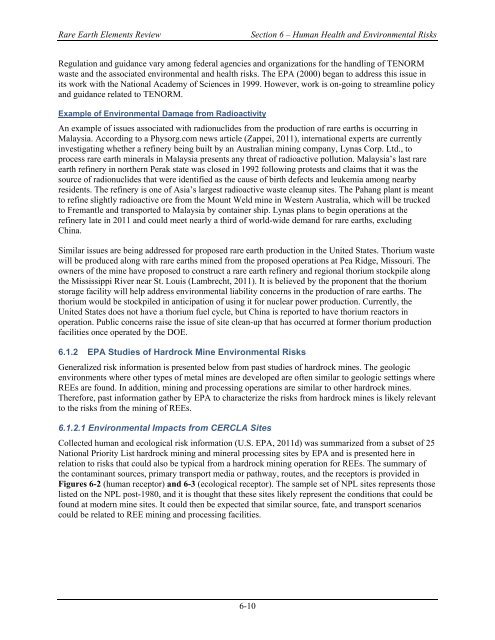Rare Earth Elements: A Review of Production, Processing ...
Rare Earth Elements: A Review of Production, Processing ...
Rare Earth Elements: A Review of Production, Processing ...
You also want an ePaper? Increase the reach of your titles
YUMPU automatically turns print PDFs into web optimized ePapers that Google loves.
<strong>Rare</strong> <strong>Earth</strong> <strong>Elements</strong> <strong>Review</strong> Section 6 – Human Health and Environmental Risks<br />
Regulation and guidance vary among federal agencies and organizations for the handling <strong>of</strong> TENORM<br />
waste and the associated environmental and health risks. The EPA (2000) began to address this issue in<br />
its work with the National Academy <strong>of</strong> Sciences in 1999. However, work is on-going to streamline policy<br />
and guidance related to TENORM.<br />
Example <strong>of</strong> Environmental Damage from Radioactivity<br />
An example <strong>of</strong> issues associated with radionuclides from the production <strong>of</strong> rare earths is occurring in<br />
Malaysia. According to a Physorg.com news article (Zappei, 2011), international experts are currently<br />
investigating whether a refinery being built by an Australian mining company, Lynas Corp. Ltd., to<br />
process rare earth minerals in Malaysia presents any threat <strong>of</strong> radioactive pollution. Malaysia’s last rare<br />
earth refinery in northern Perak state was closed in 1992 following protests and claims that it was the<br />
source <strong>of</strong> radionuclides that were identified as the cause <strong>of</strong> birth defects and leukemia among nearby<br />
residents. The refinery is one <strong>of</strong> Asia’s largest radioactive waste cleanup sites. The Pahang plant is meant<br />
to refine slightly radioactive ore from the Mount Weld mine in Western Australia, which will be trucked<br />
to Fremantle and transported to Malaysia by container ship. Lynas plans to begin operations at the<br />
refinery late in 2011 and could meet nearly a third <strong>of</strong> world-wide demand for rare earths, excluding<br />
China.<br />
Similar issues are being addressed for proposed rare earth production in the United States. Thorium waste<br />
will be produced along with rare earths mined from the proposed operations at Pea Ridge, Missouri. The<br />
owners <strong>of</strong> the mine have proposed to construct a rare earth refinery and regional thorium stockpile along<br />
the Mississippi River near St. Louis (Lambrecht, 2011). It is believed by the proponent that the thorium<br />
storage facility will help address environmental liability concerns in the production <strong>of</strong> rare earths. The<br />
thorium would be stockpiled in anticipation <strong>of</strong> using it for nuclear power production. Currently, the<br />
United States does not have a thorium fuel cycle, but China is reported to have thorium reactors in<br />
operation. Public concerns raise the issue <strong>of</strong> site clean-up that has occurred at former thorium production<br />
facilities once operated by the DOE.<br />
6.1.2 EPA Studies <strong>of</strong> Hardrock Mine Environmental Risks<br />
Generalized risk information is presented below from past studies <strong>of</strong> hardrock mines. The geologic<br />
environments where other types <strong>of</strong> metal mines are developed are <strong>of</strong>ten similar to geologic settings where<br />
REEs are found. In addition, mining and processing operations are similar to other hardrock mines.<br />
Therefore, past information gather by EPA to characterize the risks from hardrock mines is likely relevant<br />
to the risks from the mining <strong>of</strong> REEs.<br />
6.1.2.1 Environmental Impacts from CERCLA Sites<br />
Collected human and ecological risk information (U.S. EPA, 2011d) was summarized from a subset <strong>of</strong> 25<br />
National Priority List hardrock mining and mineral processing sites by EPA and is presented here in<br />
relation to risks that could also be typical from a hardrock mining operation for REEs. The summary <strong>of</strong><br />
the contaminant sources, primary transport media or pathway, routes, and the receptors is provided in<br />
Figures 6-2 (human receptor) and 6-3 (ecological receptor). The sample set <strong>of</strong> NPL sites represents those<br />
listed on the NPL post-1980, and it is thought that these sites likely represent the conditions that could be<br />
found at modern mine sites. It could then be expected that similar source, fate, and transport scenarios<br />
could be related to REE mining and processing facilities.<br />
6-10















